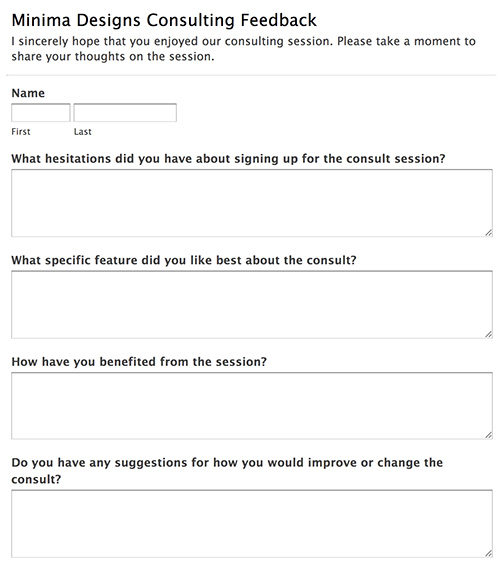Years ago I worked with a high-priced consultant who stressed the importance of his testimonials page. I thought it was way too long (printed out it came to 60 pages!) but he always emphasized how many of his clients read every single word. He knew they were motivated to contact him (and pay him) based on what they read of other’s experiences.
When I changed my protocol from randomly asking for testimonials to sending my clients a strategic feedback form, the quality (and length) of my testimonials vastly improved – and it shows on my testimonials page.
Here’s what I do to get valuable feedback from my clients that I can then use to craft my offerings, modify my processes and get invaluable testimonials that do the selling for me.
- When should you ask for a testimonial?
- What are the steps involved in getting testimonials?
- What questions should you ask when getting testimonials?
- What software tools can you use to collect testimonials?
Please note that I am an affiliate for some of the resources listed below. As an affiliate, I may earn a referral fee if you purchase these products based on my recommendations. I only recommend those services that I actually use in my own business.
When should you ask for a testimonial?
The best time to get a testimonial after purchase depends on the type of product or service you offer and the customer’s experience with it. In general, it’s best to ask for a testimonial when the customer has had enough time to fully experience and evaluate the product or service.
A good rule of thumb is to follow up with the customer shortly after the product or service has been delivered or completed to ensure they have had enough time to form an opinion, but not so much time that they have forgotten the details of their experience. This could be anywhere from immediately after the service to a few days or weeks, depending on the situation.
If you sell a physical product, you may want to wait until the customer has received the item, used it for a few days or weeks, and generated an opinion about it.
In my case, I generally ask for recommendations right after working with someone. When I do consults, I ask for a testimonial immediately after the consult when the experience is fresh in the mind of my client. If I’m doing a group training or finishing a design project I always ask for a testimonial as soon as the project is complete (and the client is likely the most excited and energized). Your time together (and the immediate benefits of your work) should be fresh in your client’s head. It’s also the perfect opportunity to get constructive feedback and discover what worked and what didn’t so you can better serve your clients.
You may want to consider doing a secondary follow up after your customer has completed a program or project and had time to see actionable results. This is a great technique especially if you’re working with a client over a long period of time or it takes weeks or months to see the true results of your work together – and you can incorporate the additional comments into a more extensive (and powerful) case study.
What are the steps involved in getting testimonials?
Just outright asking for a testimonial can feel awkward or like you’re burdening your client with one more task in their inbox – and it can be hard to get responses quickly (or at all).
Here’s what I’ve done to make it easy for clients to write (and send!) great testimonials quickly:
- Rather than simply ask “will you write me a testimonial,” put together a list of strategic questions. My testimonial form has 7 quick questions. I like to include questions that can deal with objections from future clients like “did you have any hesitations about working with me” (this question almost always brings forth a response about pricing hesitancy and then a note that they were so glad they purchased!) I’ve put a sample list of questions at the end of this post for you to use.
- Next, I created a form using Wufoo. (Typeform.com or a google form are also great tools to create feedback forms). Inside the form, I list my questions, with space for the client to respond. I also include a checkbox at the end of the form that asks for permission to use their words on my website and in my marketing materials. I also ask them to attach their preferred profile image – that way I have their testimonial, image and consent all documented and uploaded in one place.
- When I’m ready to send the form to the client, I send them a quick thank you email with a link to the testimonial form. I have this email ready to go as a canned response inside my email, so all I have to do is click one link to send the request to the client.
- The questions on the form prompt the client and they can simply fill in the boxes. This makes it WAY easier and faster for them to respond quickly to the testimonial request. By removing the barrier of asking the client to write a testimonial with no guidance you will get a much better response rate. I know I always put off testimonial requests into my “to-do-later” pile – having this simple form alleviates that stress for your clients!
- Once I get the form feedback, I then cut and paste the responses from each question to craft a full-length testimonial.
- I then save the testimonial to a google doc (for safekeeping and for quick use later on). From there, I’ll add the testimonials to my website, newsletter, sales pages and social media posts.

What questions should you ask when getting testimonials?
The question promops below (and variations thereof) are what I use to ask my clients and students when providing feedback and testimonials. Feel free to use these example questions as a starting point for your own feedback forms.
- What hesitations did you have about signing up for the [service]?
- What specific feature did you like best about the [process/service]?
- How have you benefited from the [service]?
- Do you have any suggestions for how you would improve or change the [service]?
- Would you recommend my [service]? If so, why?
- Is there anything else you’d like to add?
- Do I have your permission to use your comments and photo on my website?
What software tools can you use to collect testimonials
Testimonial.to makes it easy to gather, update and embed testimonials on your site. You can collect testimonials from a variety of sources – like social media, Google and Yelp. Where it truly shines is collecting automated testimonials. Consider if you’ve created a product and want to get reviews – you can automate the process so that a buyer is sent the testimonial form a short while after they purchase a product. You can even add incentives to nudge folks to send out their testimonials quickly. Check it out at Testimonial.to
Please note that I am an affiliate for some of the resources listed in this post. As an affiliate, I may earn a referral fee if you purchase these products based on my recommendations. I only recommend those services that I actually use in my own business.
 Michelle Martello is a Kajabi and ConvertKit (Kit) expert, award-winning digital strategist, and founder of Minima Designs. She works with entrepreneurs and creators to launch, grow, and streamline their online businesses — from creating all kinds of digital products and programs to email marketing and automation. Michelle offers 1:1 strategy consults for anyone looking to simplify the tech and build a business that actually works (and lasts).
Michelle Martello is a Kajabi and ConvertKit (Kit) expert, award-winning digital strategist, and founder of Minima Designs. She works with entrepreneurs and creators to launch, grow, and streamline their online businesses — from creating all kinds of digital products and programs to email marketing and automation. Michelle offers 1:1 strategy consults for anyone looking to simplify the tech and build a business that actually works (and lasts).
Leave a Reply